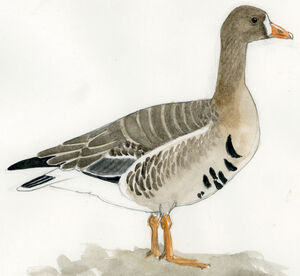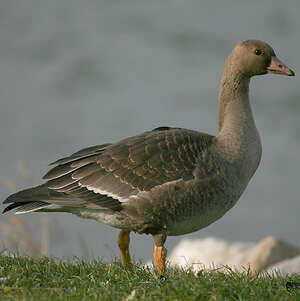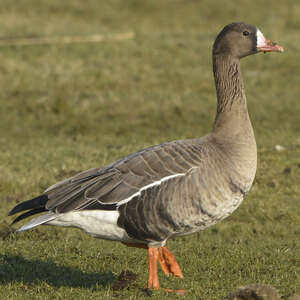Greater White-fronted Goose
Anser albifrons - Oie rieuse
Identification
The Greater White-fronted Goose is part of the geese group in the same way as the Bean Goose, the Barnacle Goose, the Tundra Goose or the Pink-footed Goose, a group so named because of the colour of the plumage of the upper parts which have more or less grey.
The Greater White-fronted Goose is visibly smaller than the other grey geese, except for the Barnacle Goose. There is also no sexual dimorphism, except for size, with males always being a little bigger than females.
An adult Greater White-fronted Goose can easily be recognised from a distance by its white face and black transverse bands that cross the light beige chest and belly. But it is not the only one. The adult Barnacle Goose also shows the same, and even if the species is a rare winter visitor to the west of the continent, it must be taken into consideration. It is careful observation of the head that provides the answer. In the case of the White-fronted Goose, the white of the face ends in a round shape at the top of the forehead (extending to the crown in the case of the Barnacle Goose) and the dark eye does not stand out on the brown of the head (the dark eye of the Barnacle Goose is circled with yellow in a clearly visible way, even for the 1st winter). Both species have a pink beak with a white tip, but the White-fronted Goose has a slightly thicker and longer one. The legs are bright orange.
The young "1st winter" differs from the adults in that there is no white on the face, nor any black bars on the lower parts. It can be identified as a young White-fronted Goose by its pink beak, whose tip is dark, and by the company of adults.
Subspecific information 5 subspecies
- Anser albifrons albifrons (n Russia)
- Anser albifrons flavirostris (w Greenland)
- Anser albifrons elgasi (s Alaska. USA.)
- Anser albifrons gambelli (Alaska, nw and nc Canada)
- Anser albifrons sponsa (w Alaska. USA.)
Foreign names
- Oie rieuse,
- Ánsar careto,
- ganso-grande-de-testa-branca,
- Blässgans,
- nagy lilik,
- Kolgans,
- Oca lombardella,
- bläsgås,
- Tundragås,
- hus bieločelá,
- husa běločelá,
- Blisgås,
- tundrahanhi,
- oca riallera grossa,
- Blesgæs,
- gęś białoczelna,
- baltpieres zoss,
- beločela gos,
- Белолобый гусь,
- マガン,
- 白额雁,
- 白額雁,
Voice song and call
Habitat
The Greater White-fronted Goose's breeding area is located in northeastern Russia, Siberia, northern North America and Greenland. Its wintering area is close to the coasts of western and southern Europe, the Middle East and the Caspian Sea. In America, it is located in California and Texas, near the Gulf of Mexico. This distribution determines two distinct habitats: in winter, tundra with sparse shrub vegetation and bodies of water; in summer, wet meadows and ponds near the coast.
Behaviour character trait
During the breeding season, the Greater White-fronted Goose is wary and even shy, but it becomes sociable after nesting. It is a migrant. Within the flocks of wintering Greater White-fronted Geese, families usually stay together. These migratory flows can be very important: in the 1980s, up to 250,000 wintering Greater White-fronted Geese were counted along the coasts of the Baltic Sea and the North Sea. When winters are severe, a large number of these birds can be seen in the north of France.
Flight
As with all wild geese, their flight is so powerful that they cross seas and mountains without any difficulty during migrations. With necks outstretched, they fly in regular formation, keeping the same distance from their neighbour and slightly ahead of the one in front of them. They fly at great heights, crossing large areas. Their flight draws a characteristic V shape in the sky. The bird in the lead, which provides the most effort, is regularly replaced.
Dietfeeding habits
Reproduction nesting
Among Greater White-fronted Geese, couples are stable and long-lasting. The nest is quite rudimentary, a simple hollow lined with some vegetation debris. No colonies, couples nest isolated. At the end of May or the beginning of June, the female lays between 5 and 6 eggs which are incubated for 27 to 28 days. The chicks are nidifugous like many other waterfowl and they take off between the 40th and 43rd day. Families stay together during the first wintering period.
Geographic range
The Greater White-fronted Goose has a holarctic distribution. It is present in the Arctic region of the northwest tip of Russia (Kali Peninsula to Hudson Bay in America, passing through the Bering Strait). The nominate subspecies occupies the entire Russian Arctic and 3 subspecies share the American Arctic. A particular subspecies, ssp flavirostris, inhabits the east of Greenland.
Threats - protection
IUCN conservation status
concern
in the Wild
threatened
evaluated
This species is not classified as threatened by BirdLife International. It is a common species with a very wide distribution. However, it can be assumed that, in the long run, if the trend does not reverse itself, the warming of our planet will surely affect the species that inhabit the Arctic.
Sources of information
- IOC World Bird List (v15.1), Gill, F and D Donsker (Eds). 2025-12-07.
- Avibase, Lepage Denis
- Guide des canards, des oies et des cygnes, Steve Madge
- Les palmipèdes d'Europe, Géroudet P., MAJ M. Cuisin
- Wildfowl: An identification guide to the ducks geese and swans of the world, Madge, S and Burn, H
- Birds of the World, The Cornell Lab of Ornithology
- xeno-canto, Sharing bird sounds from around the world,
Other sources of interest
 Specification sheet created on
28/10/2023 by Didier Collin with help of Daniel Le-Dantec
Specification sheet created on
28/10/2023 by Didier Collin with help of Daniel Le-Dantec partially rewritten on 00/00/0000 by Jean François
Translation by AI Oiseaux.net
© 1996-2026 Oiseaux.net
- Accipitriformes
- Aegotheliformes
- Anseriformes
- Apodiformes
- Apterygiformes
- Bucerotiformes
- Caprimulgiformes
- Cariamiformes
- Casuariiformes
- Charadriiformes
- Ciconiiformes
- Coliiformes
- Columbiformes
- Coraciiformes
- Cuculiformes
- Eurypygiformes
- Falconiformes
- Galliformes
- Gaviiformes
- Gruiformes
- Leptosomiformes
- Mesitornithiformes
- Musophagiformes
- Nyctibiiformes
- Opisthocomiformes
- Otidiformes
- Passeriformes
- Pelecaniformes
- Phaethontiformes
- Phoenicopteriformes
- Piciformes
- Podargiformes
- Podicipediformes
- Procellariiformes
- Psittaciformes
- Pterocliformes
- Rheiformes
- Sphenisciformes
- Steatornithiformes
- Strigiformes
- Struthioniformes
- Suliformes
- Tinamiformes
- Trogoniformes






























